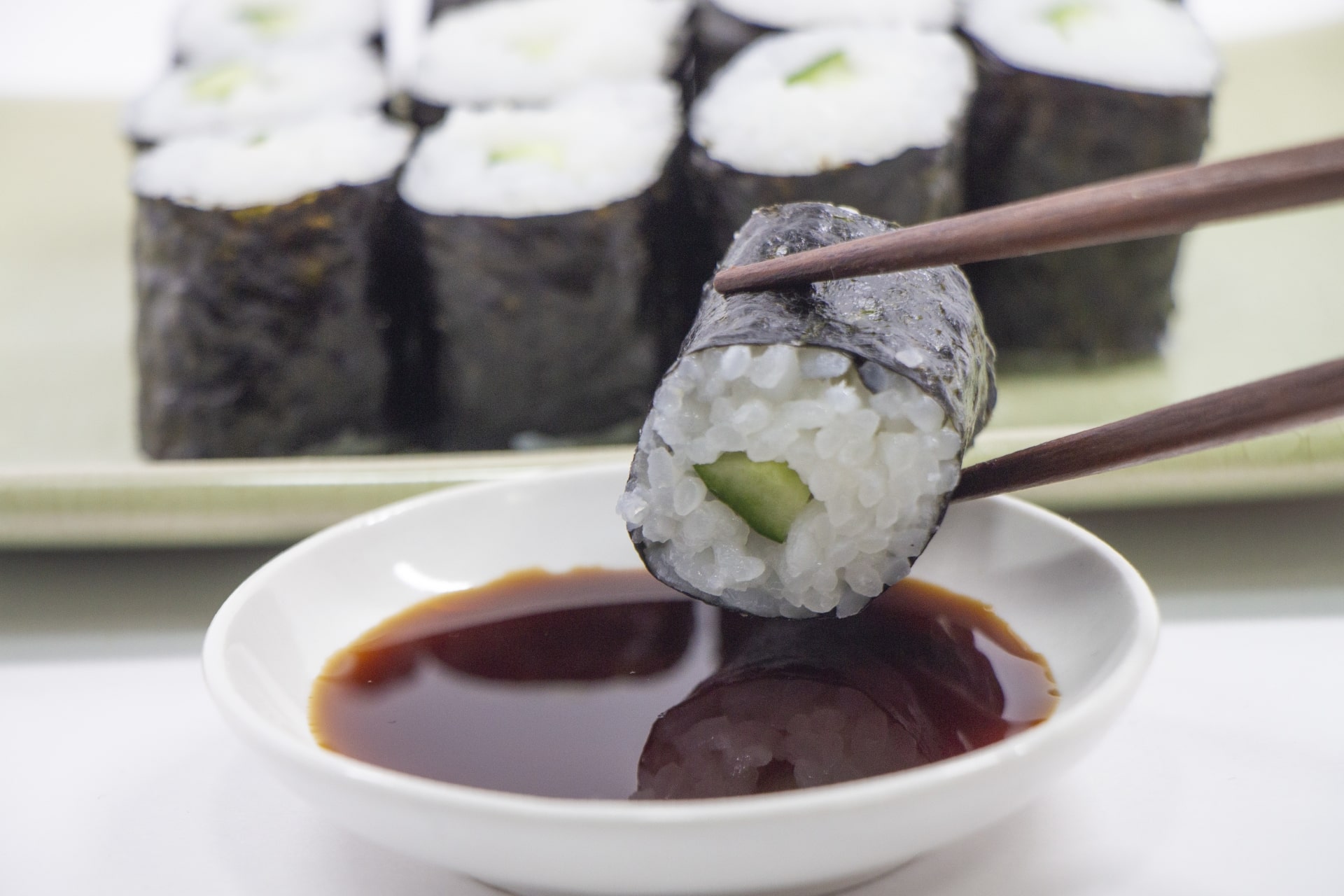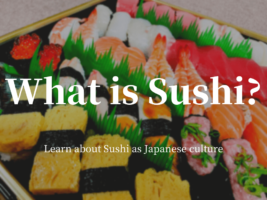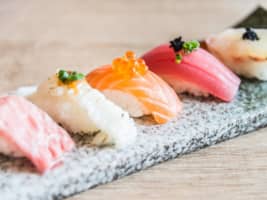How to Eat Sushi
Manners and etiquette when going to a sushi restaurant

Sushi, as you may know, is the most internationally popular Japanese food.
You will find sushi restaurants in pretty much any country and because of this, there are uncountable variations regarding recipes, interior design, ways of eating, etc.
Even within Japan, there are many types of sushi restaurants; From sophisticated traditional sushi restaurants to more family-friendly, Conveyor Belt Sushi restaurants.
I think having this many variations of sushi restaurants is a good thing. However, I also think it is important to not forget the origins of this culinary culture that “Sushi” is.
In this article, I will introduce to you how to eat sushi in the proper manner so that you won’t feel uneasy when you go to a traditional sushi restaurant.
Before we start, I would like to note that depending on the type of restaurant, there are different levels of rules or etiquette that are better if you can apply.
In many cases, people won’t mind if you’re doing something not correctly knowing that you’re here in Japan for traveling. However, as a local, it feels good to see that a visitor has studied and applied these unwritten rules regarding how to eat sushi.
Also, some of these apply not only to sushi but to all Japanese restaurants.
How to eat sushi: The basics
Ok, then. Let’s start with the basics.
When going to any traditional Japanese restaurant, it is important that you can be able to identify and enjoy the scent of the ingredients. Therefore, be sure that you don’t put on too much perfume or cologne. If you’re a smoker, you’ll also need to be careful not to go to a restaurant carrying that cigarette smell.
When sitting at the counter, be sure to take off any accessories such as rings, bracelets, and watches. Also when you’re at the counter, if you want to take a picture, be sure to ask beforehand.
Order of eating
One of the things people ask is if there is a correct order to eat sushi.
Long ago, sushi connoisseurs used to first order the egg-roll sushi. This was to determine the restaurant’s ability to prepare a nicely shaped egg roll. However, nowadays, most sushi restaurants will just buy the egg roll at a different store that specializes in that, so this practice hasn’t been continued.
Some people say that you should start with the more lean white fish sushi and gradually order fish with more fat in it. This is because if you eat lean fish sushi after having tastier fish sushi, you might not be able to enjoy the taste properly. However, this is just a matter of preference.
Most sushi restaurants will tell you to order whatever you want at whatever order you want. If you want to eat lean fish sushi after a tastier sushi, just be sure to eat a few ginger slices or drink some tea to reset your palette.
However, if you order an assort of sushi, be sure to eat the sushi pieces from left to right. The sushi shokunin (sushi master) will place the assortment in a way that the sushi shokunin believes is the best way to enjoy that assortment.
Use hands? Or chopsticks?
Another thing that many people wonder about is whether you should eat sushi using your hands or if it’s better if you use chopsticks.
Originally, sushi was designed to be eaten with your hands, but this is because sushi used to be sold at stalls. So eating sushi with your hands was quick and convenient at that time.
Some people like to eat sushi with their hands, while others like to use chopsticks to avoid having to clean your fingers in between grabbing pieces. Either way is ok.
However, depending on how you eat sushi, there are a few things you should be aware of.
If you use your hands
In the case that you want to eat sushi using your hands, use 3 fingers (index, middle, and thumb) to grab the sushi.
Be sure to clean your fingers using the Oshibori (wet towel) in between every piece of sushi. This is to avoid flavors being mixed.
Also, even if you eat the sushi with your hands, you should eat the Gari (sliced ginger) using chopsticks.
If you use chopsticks
In the case that you want to eat sushi using chopsticks, it’s important to know where to place the chopsticks every time you decide to have a sip of your drink.
If there’s a Hashioki (chopstick rest) on the table, that is where you should rest your chopsticks. But there are occasions that there’s no Hashioki on the table. In those cases, you can rest your chopsticks on the soy sauce plate. But be sure that only the front part of the chopsticks are on top of the plate (the back part of the chopsticks should be touching the table).
Another thing you can do is, in the case the chopsticks are disposable, fold the paper pocket where the chopsticks came in to create your own Hashioki.
Just so you know, things you should never do with chopsticks include; passing food from chopsticks to chopsticks, and leaving your chopsticks sticking down on a bowl. Also, don’t move a plate using your chopsticks. All these are considered pretty rude.
Using soy sauce
First, you should know that not all sushi needs to be dipped in soy sauce. Boiled clam sushi, boiled conger eel sushi, and some other sushi that have already some sauce on top don’t need soy sauce.
For the others that do need soy sauce, there are a few things that you should know.
First, when you dip the sushi in the soy sauce, make sure that only the topping is touching the sauce. In other words, the rice shouldn’t touch the soy sauce. This is to avoid rice crumbling into the soy sauce.
Some people take the topping off the rice boll to dip it in the soy sauce, but this is also not good. You shouldn’t separate the topping from the rice at any time. This is considered disrespectful to the sushi master.
In the case of Maki sushi, dip the seaweed area in the soy sauce. And in the case of Gunkan sushi, dip either the Gari or cucumber slice in the soy sauce and then let the soy sauce drip on top of the topping.
Using Wasabi
Here is where people get divided. Some people love wasabi while others rather not have it in their sushi.
For those who don’t like wasabi, it is ok to let the sushi master that you would like your sushi without wasabi. This is not considered rude.
And for those who love wasabi, there’s a thing that many do but it is actually not correct. It’s to mix wasabi with soy sauce. It is ok to have it side by side, but you shouldn’t mix it. However, even many Japanese people do this… So just be sure to not do this when you go to a high-class sushi restaurant.
Using Gari
Gari is the sliced ginger you will see at the side of sushi. Gari is said to have odor neutralizing effects as well as disinfection effects.
Also, As I mentioned before, it is a good way to cleanse your palette in between sushi pieces.
What to drink along with Sushi
Generally, people drink either green tea or brown-rice tea when eating sushi. However, sushi also goes well along with some alcoholic beverages such as Japanese sake, white wine, and sparkling wine.
If you go to a traditional sushi restaurant, they will have in their menu the best choices that will go well with sushi.
How to eat sushi: Other details
Some other details regarding how to eat sushi I haven’t mentioned so far include the following.
Be sure to eat each sushi piece in one bite. The sushi master prepares each sushi piece in a way that is best enjoyed in a single bite. therefore, it is considered rude to not eat it in a single bite. If for any reason it is difficult for you to eat the sushi in a single bite, you can ask the sushi master to make the rice ball smaller so that you can eat it in a single bite.
Another thing you should be careful of is when sitting at the counter, be sure not to move the Geta (wood plate where the sushi master places the sushi) near you. The Geta is strategically placed just in between you and the sushi master.
I hope you enjoyed this article.
As I mentioned in the beginning, these are not all the rules, however, I chose the most important ones so that you have an idea of how to eat sushi when you come to Japan.
There’s a big difference between eating sushi not being sure if you’re doing the correct thing and eating sushi being confident that you’re eating it in the correct way.
I hope this article helps you get closer to the latter type.
▽This Complete Sushi Guide introduces all about the authentic Japanese sushi▽
If you enjoyed this article and want to know more about Sushi, be sure to check out the following articles!
▽Related Articles▽
▼Editor’s Picks▼
Written by
Born and raised in Costa Rica, I started living in Tokyo from college. I love traveling within Japan & around the world. Since I wasn’t born in Japan, I know the cultural impact that you can get when visiting Japan for the first time and what you might be worried about before your trip. And I’ve lived long enough to somewhat understand the nuances of the Japanese culture that make this country such an attractive place to visit. Hopefully I can provide to you both the information you’re looking for and the information you didn’t know you needed to know.























